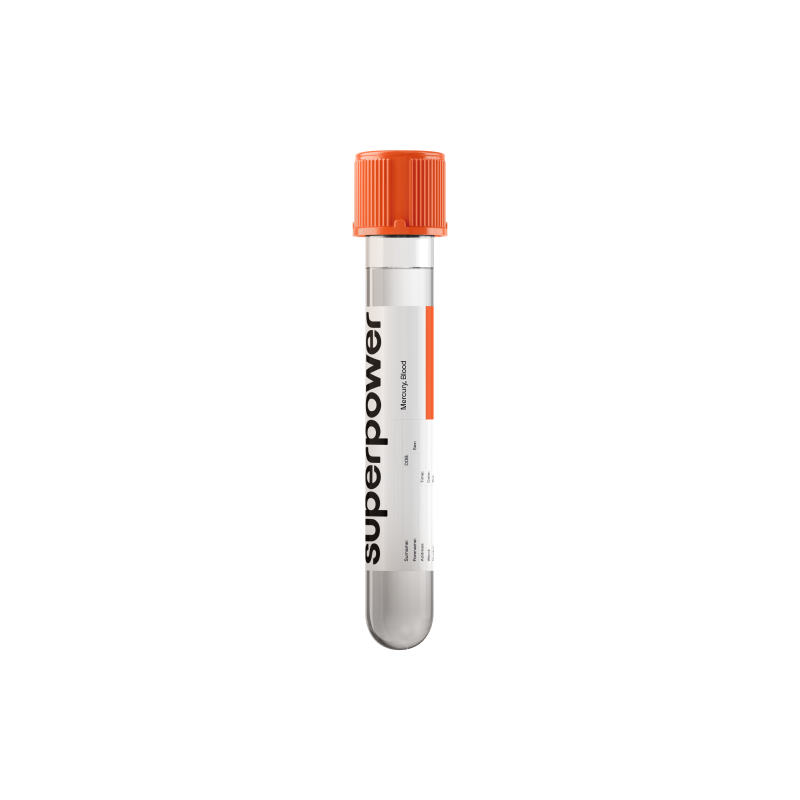Key Benefits
- Check your recent mercury exposure from fish, work, or environmental sources.
- Spot early elevations that can harm nerves, kidneys, and the developing brain.
- Explain numbness, tingling, tremor, or memory issues linked to mercury burden.
- Guide safer seafood choices by linking levels to fish type and frequency.
- Protect fertility and fetal development by detecting levels needing prompt reduction.
- Track progress after removing sources or during doctor-directed mercury-removal treatment.
- Clarify exposure type with urine mercury and, when needed, hair testing.
- Support occupational health monitoring in jobs using mercury-containing equipment or processes.
What is Mercury, blood?
Mercury, blood measures the amount of mercury circulating in your bloodstream. Mercury is a naturally occurring heavy metal that enters the body mainly through eating contaminated fish and seafood (methylmercury, CH3Hg+), and through inhaling mercury vapor in certain workplaces or products (elemental mercury, Hg0), which can be converted to inorganic mercury (Hg2+). In blood, methylmercury preferentially binds to red blood cells, while inorganic mercury binds to proteins in the plasma. The result captures the mixture of organic and inorganic forms currently in circulation.
Mercury has no beneficial role in human biology. It binds tightly to sulfur-containing groups on proteins (thiols), interfering with enzymes and cellular signaling, especially in the nervous system and kidneys. Blood mercury therefore serves as a marker of toxic exposure and the mercury load being delivered to tissues. Because methylmercury crosses the blood–brain barrier and the placenta, the blood level reflects what can reach the brain and a developing fetus. Clinically, it indicates recent exposure—most commonly from diet—and helps gauge how much mercury is available to distribute to organs or be eliminated through bile and urine.
Why is Mercury, blood important?
Mercury, blood measures recent exposure to a neurotoxic heavy metal that readily crosses the blood–brain and placental barriers. Most circulating mercury is methylmercury from fish and marine mammals; smaller fractions can reflect elemental or inorganic sources. Because mercury targets neurons, kidneys, and the cardiovascular and immune systems, this test matters for brain health, child development, pregnancy, and long‑term organ function.
Typical laboratory ranges sit at very low values; optimal tends to be toward the low end. Blood levels mirror exposure over the prior several weeks, making this a useful snapshot of current body burden, especially for methylmercury.
When values are low or near zero, they simply reflect minimal exposure. Mercury has no beneficial physiologic role, so low results do not cause symptoms. In women who are pregnant or may become pregnant, and in children and teens with developing brains, lower levels are particularly desirable because vulnerability to neurotoxicity is higher.
Higher values indicate recent significant exposure. The nervous system is most sensitive: people may notice tingling in hands or feet, trouble with coordination, visual field constriction, tremor, headaches, irritability, or sleep changes. Children can show learning or behavioral effects, and fetal exposure can impair neurodevelopment. The kidneys may develop tubular injury with protein in the urine, and immune dysregulation and rashes can occur with inorganic forms. Elevated levels have also been linked to higher blood pressure and increased cardiovascular risk.
Big picture: blood mercury connects environmental exposure to neurologic integrity, renal function, and heart health. Interpreted alongside exposure history and, when needed, urine mercury (for inorganic/elemental forms), it helps gauge risk for cognitive effects, kidney dysfunction, and adverse pregnancy and developmental outcomes.
What Insights Will I Get?
Mercury, blood measures the amount of mercury circulating in whole blood, which mainly reflects recent exposure to methylmercury bound to red blood cells. Mercury crosses the blood–brain and placental barriers and can disrupt cellular energy production, antioxidant defenses, and neurotransmission. Systems most affected include the nervous system, kidneys, and cardiovascular system, with potential effects on cognition, motor control, blood pressure regulation, and fetal neurodevelopment.
Low values usually reflect minimal recent exposure and a low circulating body burden. Because mercury is not a required nutrient, low levels carry no physiologic downside. In children and during pregnancy, lower values indicate a reduced risk of neurodevelopmental toxicity, since less mercury is available to cross the placenta or affect the developing nervous system.
Being in range suggests background exposure typical of the general population, with detoxification and excretion keeping pace with intake. At these levels, inhibition of selenium-dependent enzymes, oxidative stress, and mitochondrial interference are unlikely to be clinically meaningful. Many experts consider the optimal zone to be toward the lower end of the reference interval, particularly for pregnancy and early childhood.
High values usually reflect significant recent intake of methylmercury (often via seafood) or exposure to inorganic/elemental mercury. Physiologically, mercury binds sulfhydryl groups, impairs mitochondrial respiration, and alters neurotransmitter signaling. Common system-level effects include sensory changes, fine motor and cognitive slowing, kidney tubular injury, and in pregnancy, increased risk to fetal neurodevelopment. Higher levels have also been linked to elevated blood pressure and atherosclerotic risk.
Notes: Blood mercury reflects exposures over recent weeks and can rise transiently after a seafood meal. Whole blood is preferred; hair can index longer-term methylmercury, and urine better reflects inorganic mercury. Pregnancy hemodilution and hematocrit changes can shift values. Assay methods vary, so interpret within the laboratory’s reference range.



.svg)



.png)
.png)
.png)
.png)








